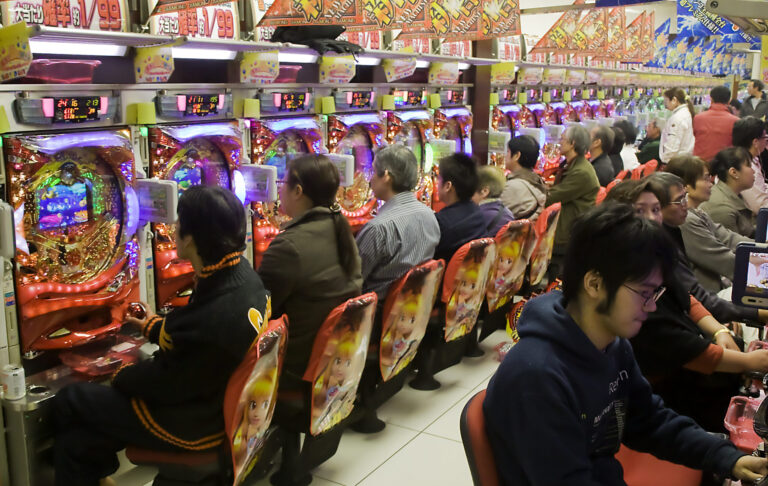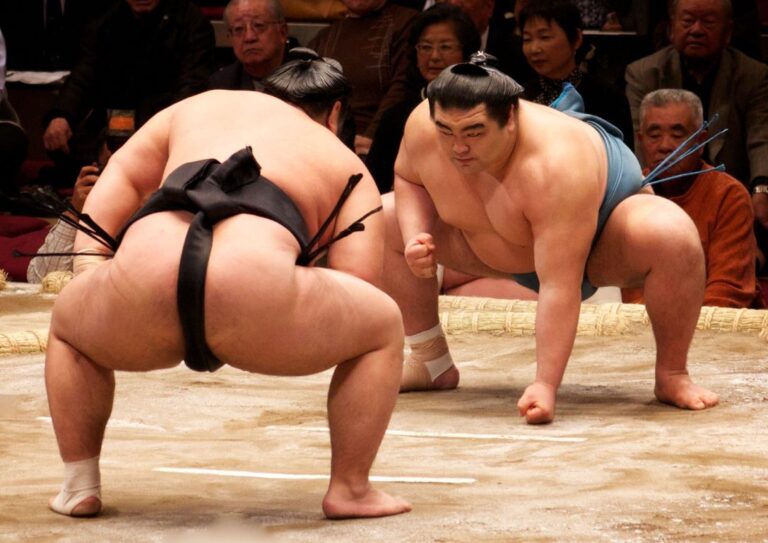Noh (and Kyougen)
The earliest form of Japanese theater, noh began in the 14th century by combining a popular Chinese performing art (called sarugaku in Japan), a Japanese dance style called dangaku, and various folk arts. This slow-moving, musically-chanted dramatic form of theater has been known to bore a number of modern Japanese children dragged along to the theater because of a field trip, but the spectator looking to see a truly artistic slice of Japanese culture is sure to enjoy it.
Traditionally, only men are involved in noh theater, although women were originally a part of the art form until 1629, when the Japanese government banned women from performing in the theater, claiming this action would “protect public morals.” However, there are still women roles in the noh plays and some noh actors train themselves to act exaggeratedly feminine even in private life in order to exclusively play these female roles.
Taiko Drummer
The shite (main character) wears traditional nou-men, a series of very minimalist noh masks reminiscent of Japanese woodblock art, that express his characters’ feelings, while the shitezure (the main character’s companion) will likewise don a nou-men for certain characters, particularly for women. There are only two other actors in a noh play: the waki (the main characters’ foil) and the waki’s companion, the wakizure. The four actors are accompanied by a chorus and four instrumentalists who play the fue (transverse flute), kotsuzumi (shoulder-drum), ootsuzumi (hip drum), and taiko (stick drum).
The kyougen play, which has spun off into its own art form, was first developed as an intermission for a noh play. These little mini-plays (as long as thirty minutes in and of themselves) were meant to be comedies in order to entertain the audience with laughter in the midst of the noh play’s heavy drama. They may explain the noh play’s plot in further detail, parody the noh play, or be self-contained stories. Like noh, the actors are accompanied by music, but the use of masks is rare.
Kabuki
Probably one of the most widely recognized styles of Japanese theater, kabuki was developed in the very early 17th century by a troupe of women performers looking to entertain the common folk—who could not afford to attend noh plays—with dance and comedy about everyday living. Ironically, like with noh, women were forbidden to perform in theatrical acts in 1629 and to this day, kabuki is traditionally performed with only male actors, who adopted that earliest form of kabuki and shaped it to what it is today.
keshou-style
Unlike noh plays, kabuki plays are meant to excite and stimulate (although the modern audience may not be as entertained at this form of theater as were the audiences of old!). The stage is constructed to have trap doors so actors can make sudden appearances and disappearances. Actors “fly” across the stage on wires, wear brightly colored and flamboyant outfits, and paint their faces in the keshou style: pure white with almost tribe-like patterns of bright color (which represent the characters’ innate characteristics) across their faces.
The audience is encouraged to participate by shouting out names and answering characters’ questions while the performance is ongoing. One of the most predominant features of a kabuki play is the frequent mie poses, in which an actor will roll his head and strike an iconic pose, holding that position while the audience shouts encouragement and appreciation.
Like with noh theater, music is an important feature of kabuki theater. The most essential instrument is the shamisen, a uniquely Japanese instrument reminiscent of a long-handled guitar with only three strings. A specially-trained narrator called the “benshi” accompanies the shamisen by belting out the play’s action in a loud, steady, stylistic voice and alternates the play’s pun-ridden dialog with the actors.
Other Styles
Other Japanese theater styles include bunraku, a style of puppet theater with origins similar to kabuki’s in the 17th century, and takarazuka, which began in 1913 after the repeal of the ban of women in theater and which features an entirely female acting troupe, including women who devote themselves exclusively to male roles, just as some Japanese male actors have done with female roles for centuries.



